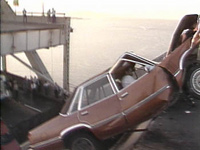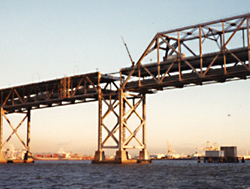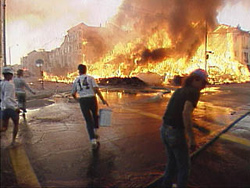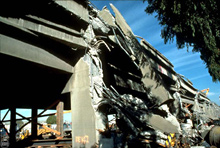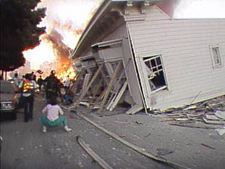
|
||||||||||||||||
|
|
|
Remembering Loma Prieta
Within minutes, powerful seismic waves rattled buildings, freeways, and nerves all over Santa Cruz County and the San Francisco Bay Area. In pockets of destruction, the earthquake crumbled buildings, freeways, and bridges, and knocked out power to homes, businesses, and Candlestick Park, where the World Series was under way. A 50-foot section of the upper deck of the Bay Bridge fell onto the lower deck, and farther east, a mile-long section of a double-deck freeway collapsed, trapping commuters between the layers. In San Francisco's Marina district, where the Exploratorium is located, 150 buildings were damaged and 35 expensive homes and apartment buildings collapsed, igniting fires that lit the sky for most of the night. It's especially ironic that the Marina district was hit so hard, since the entire area was built on landfill made from the ruins of the 1906 quake. In fact, to demonstrate San Francisco's recovery from the 1906 disaster, rubble from that earthquake was used in building the Palace of Fine Arts—home of the Exploratorium—as well as other buildings constructed for the 1915 Panama-Pacific Exposition. After the 1906 quake, the Marina district went through a housing boom, setting up the opportunity for history to repeat itself.
The Exploratorium, which had gone through some earthquake retrofitting, survived Loma Prieta, but dozens of other buildings did not. Four-story apartment buildings compacted to two stories. Other structures simply tumbled into their parking garages. A broken gas main exploded near Divisidero and Jefferson streets, igniting a fire among the densely built wooden buildings. Because the water main had broken when the earthquake hit, water to fight the Marina fires had to be drawn from the lagoon behind the Exploratorium. At 6 p.m., the city's fireboat arrived in the Marina harbor, providing much-needed water to bring the fires under control. Exploratorium staff members joined area neighbors hauling hoses from the fireboat to fight the blazes. After the earthquake, I had the desperate urge to run away. Instead, I stayed home, fielding calls from worried friends and relatives, and listening to the radio. Breathless reporters relayed stories of cars driving into a chasm created when a section of the upper deck of the Bay Bridge collapsed. On the pancaked section of the Cypress Freeway in Oakland, hundreds of commuters were feared dead. Throughout that long evening and night, rescuers squeezed into the four-foot gap between the sandwiched freeway decks, pulling survivors out of cars. We learned later than 42 people had been killed by the collapsing road; perhaps people had gone home early to watch the World Series, leaving a lighter than normal evening commute.
|
Live Eye • Great Shakes • Quake Basics • Damage Control • Active Zone

